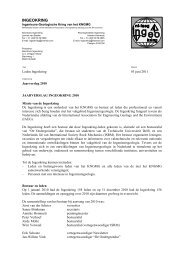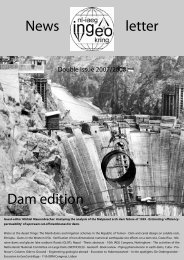environment
environment
environment
- No tags were found...
You also want an ePaper? Increase the reach of your titles
YUMPU automatically turns print PDFs into web optimized ePapers that Google loves.
Vol. 11 No. 1 2004<br />
ENVIRONMENT<br />
BioSealing: how micro-organisms become our little<br />
allies in repairing leaks<br />
John Lambert, Vasco Veenbergen, Eline van der Hoek & Sonja Karstens (GeoDelft), For more information:<br />
J.W.M.Lambert@geodelft.nl<br />
This article presents a new method for leak repair in underground constructions like sheet piles and contamination<br />
retaining barriers, being developed at GeoDelft in close cooperation with Delft University of Technology and Visser and<br />
Smit Bouw and funded by the Ministry of Economic Affairs. The method is called BioSealing and makes use of natural<br />
processes in the soil and the groundwater. BioSealing can be used to prevent water leaking through geotechnical<br />
constructions as well as to prevent migration of contaminants in contaminant retaining constructions. In this article the<br />
method of BioSealing is described and illustrated by results from laboratory experiments and the first results of current<br />
field experiments.<br />
1. Introduction<br />
In civil engineering and in <strong>environment</strong>al geotechnics<br />
underground water retaining barriers are frequently<br />
applied. In a lot of parts of the Netherlands a shallow<br />
ground water table is present. During civil engineering<br />
projects water barriers such as sheet piles need to be<br />
able to work under dry conditions. Underground water<br />
retaining constructions are designed to be impermeable.<br />
Although a general agreement exists that prevention of<br />
leaks has a high priority this appears not always to be<br />
possible. Unfortunately, in practice a lot of these (temporary)<br />
water barriers in underground constructions<br />
appear to be more permeable than they are designed<br />
for. Occasional leaks lead to the need for excessive<br />
groundwater extraction (involving higher costs and<br />
potential problems with drainage permissions), damage<br />
in the surroundings by settlement and therefore large<br />
delays in the construction time. For <strong>environment</strong>al<br />
purposes water retaining barriers are designed to prevent<br />
migration of contaminants. Examples are underground<br />
barriers underneath waste disposal sites, chemical<br />
industry plants and gasoline stations. These barriers<br />
may have an extremely low permeability when they are<br />
constructed but have to stay in place for a long time or<br />
even “forever”. During that lifetime the barrier might be<br />
damaged and therefore not prevent the contaminants<br />
from migrating through the groundwater anymore. This<br />
contaminant migration may lead to <strong>environment</strong>al risks<br />
and/ or higher amounts of groundwater to be extracted<br />
with cleaning and disposal costs.<br />
Not all leaks need to be restored. Whether or not a leak<br />
needs to be repaired depends on the risks involved, the<br />
costs and the fall-back scenarios. After it is decided<br />
that the leak needs to be repaired a number of methods<br />
Figure 1: Schematic experimental set up (left) and photo of a column (right)<br />
9




